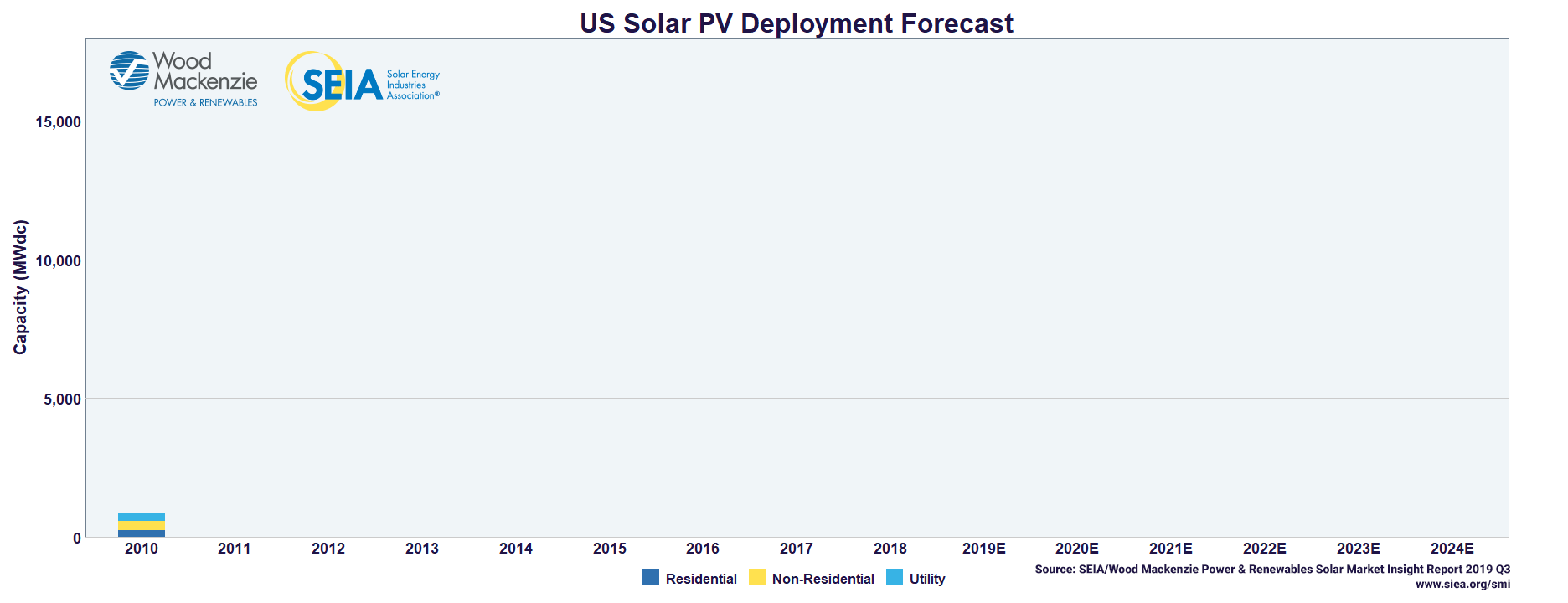U.S. Utility Solar Pipeline Soars to 37.9 GW, A New Record
WASHINGTON, D.C. and HOUSTON, TX – The U.S. solar industry now has the largest pipeline of utility-scale solar projects in history, signaling promising future prospects for solar energy development.
According to the latest U.S. Solar Market Insight Report from Wood Mackenzie and the Solar Energy Industries Association (SEIA), the contracted pipeline has ballooned to a record 37.9 gigawatts (GW), the highest in the history of U.S. utility solar photovoltaics (PV). This follows record-high procurement of 15 GW in 2018. More than 6 GW of solar capacity were added to the five-year forecast since last quarter because of the uptick in utility-scale deals.
Utility solar project announcements surged to 11.2 GW in the first half of 2019, with 6.2 GW contracted in Q2 alone. In addition to the utility solar pipeline growth, residential solar deployment rebounded from the same period last year.
“It’s no surprise that the U.S. solar pipeline is surging as costs continue to fall and solar becomes the lowest cost option for utilities, corporations and families,” said Abigail Ross Hopper, president and CEO of SEIA. “However, as we push for solar to represent 20% of U.S. electricity generation by 2030, smart policies like an extension of the solar Investment Tax Credit will be critical to reach this goal.”
FIGURE: U.S. Solar PV Price Declines and Deployment Growth

Source: SEIA/Wood Mackenzie
According to the report, several utilities have announced large solar procurements and corporate off-takers such as Starbucks, Microsoft and Anheuser-Busch have also made major announcements.
In fact, off-site corporate solar procurement represents 17% of the new utility-scale solar capacity announced in 2019.
“As more companies commit to 100% renewable power, corporate offsite procurement is expected to drive more than 20% of new utility-scale capacity additions from 2019 through 2024,” said Colin Smith, senior solar analyst with Wood Mackenzie. “Cities, states and utilities are already following through on their renewable energy and zero carbon commitments. We’re starting to see procurement occur and expect even more RPS-driven procurement in the near- to mid-term.”
The report authors note that 55% of utility-scale projects announced in 2019 were the result of solar’s economic competitiveness with other generation sources. Utility-scale solar prices are at their lowest point ever, with recent power purchase agreements signed for $18 – $35 per megawatt-hour.
In Q2, 1 GW of utility-scale PV came online in the United States, representing nearly half of the total 2.1 GW installed in the quarter. The residential segment, helped by emerging state markets, saw both quarterly growth of 3% and annual growth of 8% this quarter. Meanwhile the non-residential segment, comprising of commercial, industrial, non-profit and community solar installations, experienced both quarterly and annual declines due to policy transitions and persistent interconnection issues in key markets.
FIGURE: U.S. PV Installation Forecast, 2010-2024E

Source: Wood Mackenzie
Key findings from the report include:
- U.S. utility PV has seen 11.2 GWdc of new projects announced in the first half of 2019, bringing the utility PV pipeline to a historic high of 37.9 GWdc.
- In Q2 2019, the U.S. solar market installed 2.1 GWdc of solar PV, representing a 7% decline from Q2 2018.
- Residential solar continues its rebound, growing 3% quarter-over-quarter and 8% year-over-year. Q2 2019 was the fourth consecutive quarter of more than 600 MWdc of installed residential capacity.
- Non-residential PV saw 426 MWdc installed — a decline from Q1 — as policy shifts in states like California, Massachusetts and Minnesota continue to impact growth.
- Wood Mackenzie forecasts 17% year-over-year growth in 2019, with 12.6 GWdc of installations expected. In total, more than 6 GW were added to the five-year forecast since last quarter to account for new utility-scale procurement.
- Total installed U.S. PV capacity will more than double over the next five years, with annual installations reaching 17.6 GWdc in 2021 prior to the expiration of the federal Investment Tax Credit (ITC) for residential systems and a drop in the commercial tax credit to 10% for projects not yet under construction
###
About SEIA®:
Celebrating its 45th anniversary in 2019, the Solar Energy Industries Association® is the national trade association of the U.S. solar energy industry, which now employs more than 242,000 Americans. Through advocacy and education, SEIA® is building a strong solar industry to power America. SEIA works with its 1,000 member companies to build jobs and diversity, champion the use of cost-competitive solar in America, remove market barriers and educate the public on the benefits of solar energy. Visit SEIA online at www.seia.org.
About Wood Mackenzie:
Wood Mackenzie, a Verisk Analytics business, is a trusted source of commercial intelligence for the world’s natural resources sector. We empower clients to make better strategic decisions, providing objective analysis and advice on assets, companies and markets. For more information, visit: www.woodmac.com or follow us on Twitter @WM_PowerRenew
WOOD MACKENZIE is a trade mark of Wood Mackenzie Limited and is the subject of trade mark registrations and/or applications in the European Community, the USA and other countries around the world.
Media Contact:
Morgan Lyons, SEIA’s Senior Communications Manager, mlyons@seia.org (202) 556-2872
Mike Munsell, Wood Mackenzie, michael.munsell@woodmac.com | Chloe Holden, Wood Mackenzie chloe.holden@woodma.com

